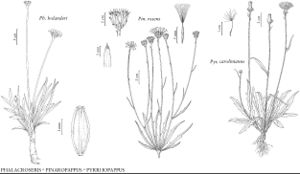Pinaropappus
Syn. Gen. Compos., 143. 1832.
| Taxon | Illustrator ⠉ | |
|---|---|---|
 | Phalacroseris bolanderi Pinaropappus roseus Pyrrhopappus carolinianus | Yevonn Wilson-Ramsey Bee F. Gunn Marjorie C. Leggitt |
Perennials, 3–40 cm; taprooted (taproots deep, woody) or rhizomatous. Stems 1–20+, erect or ascending, simple or branched proximally, ± scapiform, glabrous. Leaves basal and cauline; petiolate; basal blades linear to lanceolate, margins entire, toothed, or pinnately lobed (faces glabrous); cauline foliaceous or reduced to minute bracts distally. Heads borne singly. Peduncles not inflated distally, sometimes bracteate. Calyculi 0. Involucres cylindric to campanulate, 3–20 mm diam. Phyllaries 18–22 in 3–5 series, ovate to lanceolate, unequal, margins scarious, apices acute. Receptacles slightly convex, slightly pitted, glabrous, paleate (paleae scarious, acuminate). Florets (10–) 20–40 (–60); corollas pink, purple, lavender, or nearly white. Cypselae golden or yellowish-brown, cylindric or fusiform, tapered to slender beaks, ribs 5–6, rounded, obscure, scabrous or hispidulous; pappi persistent, of 15–60, distinct, tawny or yellowish-brown, unequal, barbellulate bristles in 1 series.
Distribution
North America, Mexico, Central America
Discussion
Species 7–10 (2 in the flora).
Plants of Pinaropappus are recognized by the glabrous leaves in dense rosettes, scapiform stems, graduated phyllaries, and pale lavender and whitish corollas. They are commonly found in dry, rocky, limestone habitats; some species are cliff-dwellers.
Selected References
None.
Lower Taxa
Key
| 1 | Plants 3–7 cm (forming dense clumps and mats); involucres cylindric, 8–10 × 3–5 mm; phyllaries purplish, margins white, apices purplish to dull brown (necrotic) | Pinaropappus parvus |
| 1 | Plants 10–30 cm (forming individual rosettes or clumps); involucres campanulate, 10–15 × 12–20 mm; phyllaries pale green, margins pink, apices dark brown | Pinaropappus roseus |
"fine" is not a number.